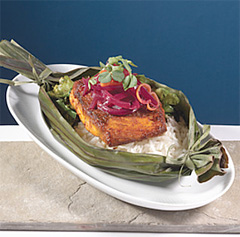 |
 |
 |
 Entertainment | Restaurants & Dining | October 2007 Entertainment | Restaurants & Dining | October 2007  
Kitchen Comes Alive On Day of the Dead
 Heather McPherson - Olando Sentinel Heather McPherson - Olando Sentinel
go to original


| | Yucatan-style snapper with achiote, rice and salsita. (Shimon & Tammar Rothstein/Andrews Mcmeel) |
Despite the dreary name, El Dia De Los Muertos (or Day of the Dead) is marked by vibrant bouquets of marigolds, heaping plates of favorite foods and lively parties that all celebrate lost loved ones in the ancient Mexican tradition.

Today through Friday, Mexican families gather at graves of relatives to offer gifts to the dead that include bottles of tequila, colorfully decorated sugar skulls, candies and Pan de Muerto bread.

"The traditional sweet bread served on El Dia De Los Muertos is formed into logs or skulls with strips of dough attached to look like bones," says chef Scott Linquist, author of Mod Mex: Cooking Vibrant Flavors at Home (Andrews McMeel Publishing, $24.95).

"The traditions vary dramatically throughout Mexico, but they are all characterized by a blend of traditional, pre-Hispanic Mexican culture and modern twists."

Thousands of years ago Mayan and other early indigenous civilizations commonly displayed skulls as trophies during rituals symbolizing death and birth.

"After the Spanish conquest of Mexico, Catholic priests moved the celebrations to coincide with All Saints' Day and All Souls' Day on the Christian calendar," says Linquist.

With the modern celebrations starting today, home cooks can use the holiday to add a diverse twist to their Halloween menus. In the spirit of the holiday, today's recipes look at a few inspired culinary reincarnations of Mexican classics.

"These dishes are respectfully based on the old-age traditions of Mexican mamacitas and fine cooks across the country," says Linquist. "But all have been adapted to appeal to a generation of food-savvy diners."

Shoppers guide to common ingredients in Mexican cookery

• Manzano chilies : Bright yellow in color, these are sometimes called peron s. They look like large, golden habaneros. Add them to very cold or warm soups for soothing dishes.

• Tomatillo morado: Unlike regular tomatillos, which have the appearance of medium-size green tomatoes in a parchment-like husk, these pint-size wonders are purple-tinted. About the size of marbles, tomatillo moradoes have the citrusy taste of tomatillo but are slightly more tart. Chop and use in salsas and sauces. Always taste before adding salt. Often you find you don't need it.

• Epazote: A weedy, hard-to-find herb that grows in parts of central and southern Mexico. Epazote is the specific flavor necessary for making authentic black beans. It has a camphorlike medicinal taste.

• Pepitas: Pumpkin seeds. Pepitas are eaten as a snack; they're popped in the mouth to crack the hull. The hull is sometimes discarded, and sometimes it is eaten along with the seed inside. In Mexico, pepitas are a much more popular movie snack than popcorn.

• Guajillo chilies: Deep brown-red, dried chili about 4-6 inches long and about 1 inch wide. Remove the seeds and stems, soak them overnight, drain them and puree them with clean water. Combine the guajillo puree with herbs and spices. Use it as a marinade for red snapper or pork, grilled red snapper tacos and tacos made with grilled cubes of pork. Or blend it with other things to make mole, a rich sauce with chilies and chocolate.

• Banana leaves: Mexican cooks use the leaves for flavoring, not just wrapping. They are good for wrapping tamales or can be used to encase and cook fillings for tacos - tacos al vipor . They can be used as a garnish, placed on the bottom of the plate for color. For a Mexican-style luau, wrap pork in banana leaves and cook in a deep pit.

• Poblano chilies: Large, very dark green chilies. The shape is almost like a bell pepper - broad across the top and slightly tapered at the bottom. To make chiles en nogada , stuff poblanos with picadillo (a seasoned mixture of meat, nuts and dried fruit) and top with walnut sauce and pomegranate seeds.

• Tamarindos: Their papery outer skin that covers the sticky pulp, fibers and seeds within. Tamarindos are called tamarinds in English. Tamarind is used to make agua fresca , a popular and refreshing drink. And because of its tartness, when it's soaked and strained, the pulp is wonderful in a cream sauce for fish, or in a mole to be used with seafood.

• Nopales: These cactus pads are sold in two forms. The untamed paddles are covered with thorns. The trimmed-and-sliced variety is packaged in plastic bags. The taste is something like a green bean. Avoid produce with brown edges. Boiled and drained, nopales scrambled with eggs is a very popular breakfast dish. They are great in a taco salads or tossed with vinaigrette.

• Jamaica: Dried hibiscus flowers. Use the rose-colored petals of Jamaica to make a garnet-red drink that is prized for its refreshing sour taste. It's almost like unsweetened cranberry juice. Jamaica can be a great addition to a pureed vinaigrette dressing.

• Piloncillo: Piloncillo, also called panela, is raw sugar shaped into brown cones. Piloncillo can be used in anything you want to sweeten. Dissolve the cones in water first, or grate them. Use them to sweeten pumpkin dishes or coffee. Brown sugar is a substitute.

• Cajeta: A luscious caramel sauce made from goat's milk. Spread cajeta on a bolillo , a chewy, Mexican-style French roll with pointed ends. Serve it under cr?me br?l?e or drizzled on vanilla ice cream, topped with toasted almonds or pecans.

Heather McPherson can be reached hmcpherson@orlandosentinel.com. | 
 | |
 |



